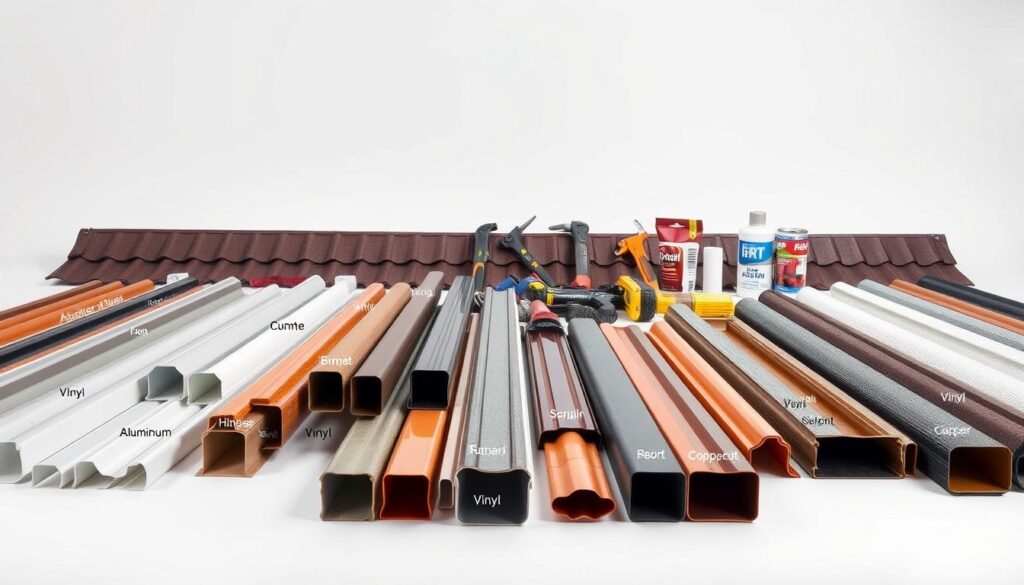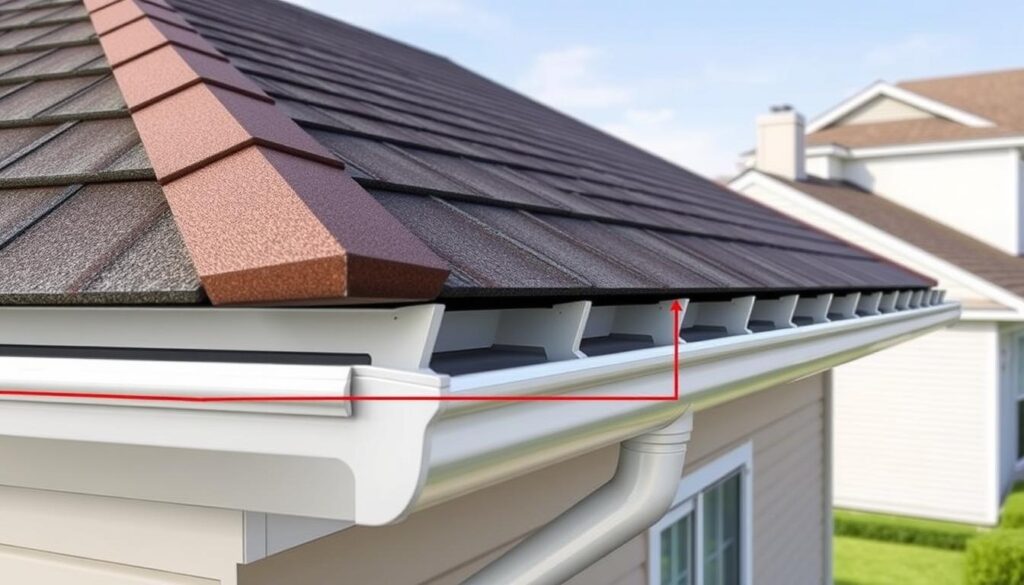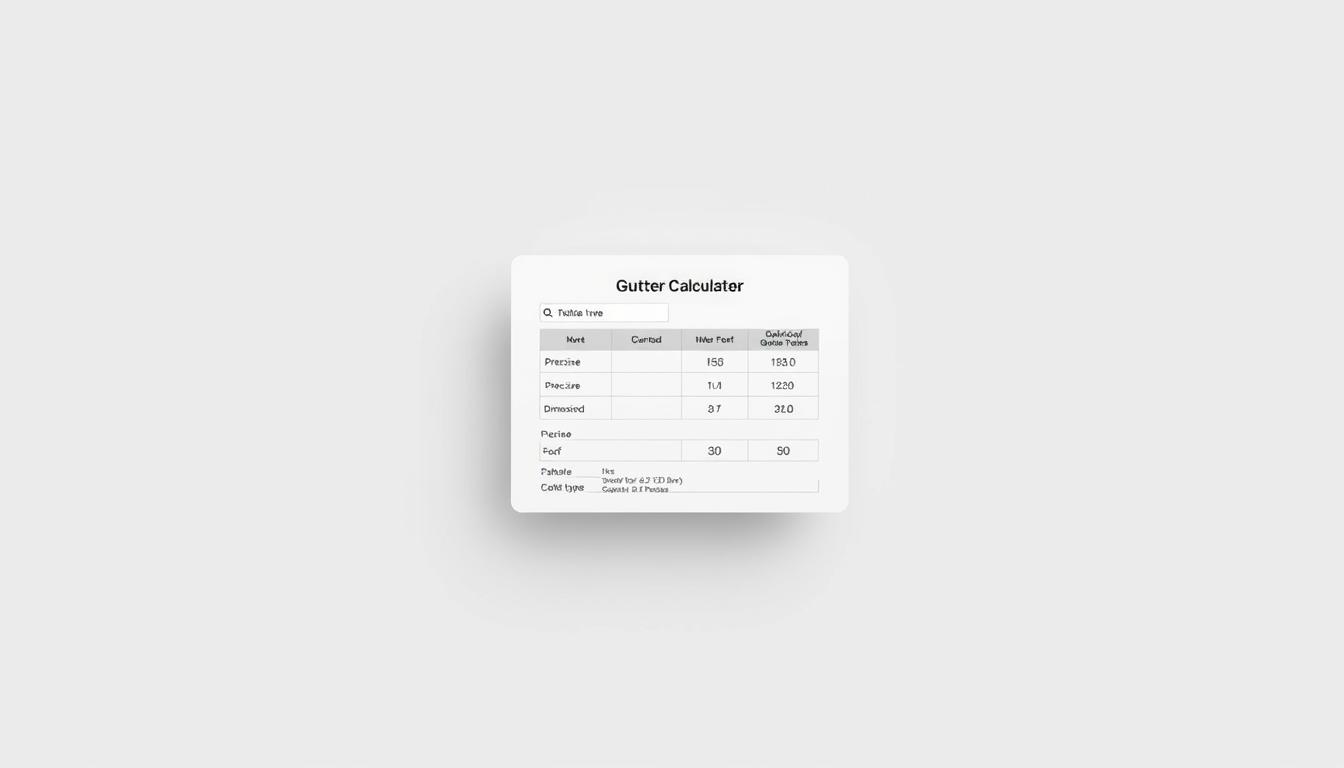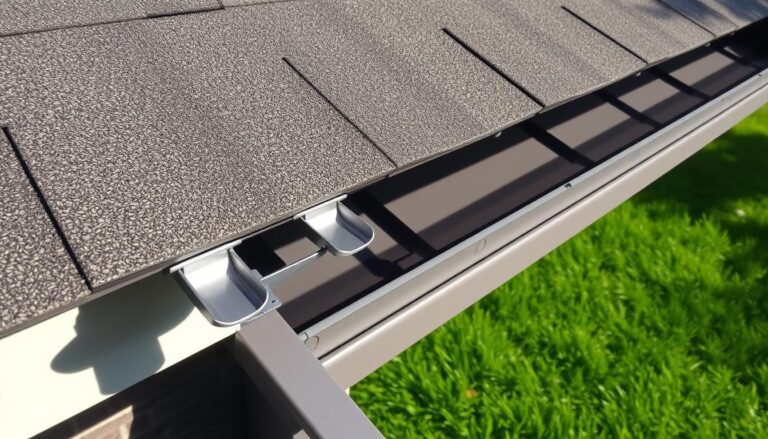How to Properly Size and Install Gutters for Your Roof Type
Getting the right gutter size and installation is key to protecting your home. Gutters help keep rainwater away from your home’s foundation, walls, and roof. This prevents expensive repairs.
We’ll show you how to pick the perfect gutter size for your roof. Roof size, pitch, and local rain levels matter. They decide what type and size of gutters you need.
Our detailed guide will help you size and install gutters correctly. This way, your home stays safe from water damage.
Understanding Different Roof Types and Their Gutter Requirements
Different roof styles need different gutter systems. It’s key to know your roof type. The design and function of your roof affect the gutters you need for water management.
Common Residential Roof Styles
Residential roofs come in many styles, like gable, hip, flat, and gambrel. Each style has its own needs for gutters.
Gable roofs are simple. But hip roofs need more complex gutters because of their slopes.
How Roof Pitch Affects Gutter Selection
The roof’s pitch is important for choosing gutters. Steeper roofs have faster water flow. This means you need bigger gutters to handle it.
“A roof with a steeper pitch requires gutters that can manage higher water velocities,” says a leading expert in residential gutter installation.
Regional Weather Considerations for Gutter Capacity
Weather in your area, like heavy rain or snow, affects gutter size. Places with lots of rain or snow need bigger gutters to avoid overflow and damage.
Essential Tools and Materials for Gutter Installation
To ensure a seamless gutter installation, you’ll need to prepare the essential tools and materials. This preparation is key for a successful project.
Required Tools Checklist
Before you start, gather the necessary tools. You’ll need a tape measure, level, drill, and screwdriver. Also, get gutter hangers, downspout connectors, and a gutter guard if you’re using one. A gutter installation cost estimator can help you plan your budget.
Gutter Materials Comparison
Choosing the right gutter material is vital. Common materials include aluminum, vinyl, and steel. Each has its pros and cons. For example, aluminum gutters are durable and resistant to corrosion. Vinyl gutters are affordable and easy to install.

Safety Equipment You’ll Need
As a professional gutter installer, safety is your top priority. Make sure you have safety glasses, gloves, a ladder stabilizer, and a harness. These will help prevent accidents.
Calculating the Right Gutter Size for Your Home
Finding the right gutter size for your home is key for managing water. A well-chosen gutter system keeps water away from your home’s foundation. This helps prevent damage.
Using a Gutter Size Calculator
Using a gutter size calculator is a simple way to find the best gutter size. These online tools consider your roof’s size, pitch, and local rainfall. They suggest the perfect gutter dimensions for you.
Standard Gutter Dimensions and Capacities
Gutters vary in size, usually between 5 to 7 inches wide. The gutter’s capacity depends on its size and shape. For most homes, a 5-inch gutter works well. But, bigger homes or steeper roofs might need larger gutters.
Downspout Sizing and Optimal Placement
Downspouts are just as vital as gutters, directing water to the ground. The size and number of downspouts depend on gutter size and local rainfall. Proper downspout placement is essential for a DIY gutter sizing guide.
Complete Guide to Gutter Sizing and Installation
To keep your home safe from water damage, it’s key to know about gutter sizing and installation. Getting the right gutter size and installing it correctly is vital. It helps manage water and protects your home.
Measuring Your Roof’s Drainage Area
First, measure your roof’s drainage area to find the right gutter size. This means figuring out the roof’s square footage that drains into the gutters. Consider the roof’s pitch and size when measuring. A bigger roof needs a bigger gutter system to handle more water.
Determining Proper Gutter Slope
A good gutter slope is important for water to flow right. It should slope 1/4 inch for every 10 feet of gutter. Getting the slope right is key for your gutter system to work well. You might need to adjust the gutter hangers to get it right.
Planning Downspout Locations
It’s important to plan where downspouts go for good water drainage. Downspouts should be at the house corners or every 30-40 feet along the gutter.
Calculating Downspouts Per Linear Foot
The number of downspouts needed depends on the gutter size and roof area. A good rule is one downspout for every 20-30 feet of gutter. A gutter size calculator can help figure out the right number of downspouts.
Addressing Drainage Path Considerations
When placing downspouts, think about the water’s path to keep it away from your foundation. Downspout extensions can help with this. Good planning of the water path prevents water from gathering around your foundation, which can damage it.

- Measure your roof’s drainage area accurately
- Determine the proper gutter slope for effective water flow
- Plan downspout locations strategically
Step-by-Step Gutter Installation Process
To keep your home dry and safe, follow our guide on installing gutters. This task needs careful planning and execution.
Preparing Your Work Area
Start by preparing your work area. Remove any debris and obstacles from around your home. Also, cover plants and landscaping to avoid damage.
Installing Fascia Brackets and Hangers
Next, install fascia brackets and hangers. These support the gutters. Measure and mark where to place them, making sure they fit your gutter type.
Assembling and Mounting Gutter Sections
Now, put together the gutter sections as the manufacturer says. This usually means connecting them with connectors and sealing the joints.
Connecting Downspouts and Extensions
Mount the gutters, then connect the downspouts and extensions. Downspouts carry water away, and extensions help keep it from your foundation.
Testing Water Flow and Making Adjustments
Test the water flow with a hose to mimic rain. Look for leaks or where water isn’t flowing right. Adjust the gutter slope or downspout placement if needed.
By following these steps, you can ensure a successful gutter installation that protects your home. Hiring a professional gutter installer is wise for complex jobs. Also, use a gutter installation cost estimator to plan your budget.
Seamless vs. Sectional Gutter Installation Comparison
It’s important to know the differences between seamless and sectional gutters. Each has its own pros and cons. These are key when picking the best gutter system for your home.
Benefits of Seamless Gutter Systems
Seamless gutters have fewer joints, which means less chance of leaks. They also look sleek and can make your home look better. But, they need a pro to install, which can cost more upfront.
DIY-Friendly Sectional Gutter Options
Sectional gutters are easier to install yourself. This can save you money on installation costs. But, they might leak more because of more joints.
Cost and Longevity Considerations
Seamless gutters cost more to install but last longer. Sectional gutters are cheaper to start but might need more upkeep. A gutter installation cost estimator can help with budgeting.
Choosing between seamless and sectional gutters depends on your budget, DIY skills, and maintenance plans. Weighing these factors helps you pick the best option for your home.
Residential vs. Commercial Gutter Sizing Differences
Gutter sizing for commercial buildings is different from homes. This is because commercial places have bigger roofs and handle more water. Commercial gutter sizing is key to manage rainwater runoff.
Commercial Building Requirements
Commercial buildings need bigger gutters because of their large roofs. They also require more downspouts to handle water runoff well.
Heavy-Duty Options for Larger Structures
Big commercial buildings need heavy-duty gutters. These gutters are made bigger and stronger. They can handle lots of water and debris.
Professional Considerations for Commercial Installation
Installing gutters in commercial buildings is complex. It’s best to hire a professional gutter installer. They can size and install gutters right. They also offer a gutter installation cost estimator for budgeting.
Maintaining Your Newly Installed Gutter System for Long-Term Performance
Keeping your gutters clean is key to their long life and good function. Regular checks and cleanings stop clogs and damage. This ensures your gutters work right.
We suggest cleaning your gutters twice a year. If you have trees close by, do it more often. Get rid of leaves and twigs. Also, look for any wear or damage.
Make sure downspouts are working right. They should be attached well and send water away from your home’s base.
Regular checks can spot problems early. Look for sagging gutters, rust, or loose parts. Fix these fast. Simple care keeps your gutters protecting your home from water harm.
Good gutter size and regular upkeep mean your home stays safe from water problems. Taking care of your gutters is an investment in your home’s future.



